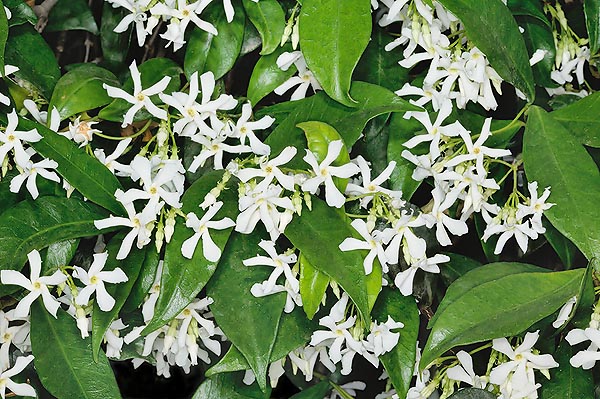Family : Apocynaceae

Text © Pietro Puccio

English translation by Mario Beltramini

Evergreen climber with very odorous flowers recalling the jasmine. Also medical © Mazza
The Trachelospermum jasminoides (Lindl.) Lem. (1851) is native to Japan, Korea, China, Laos, Thailand and Vietnam.
The name of the genus is the combination of the Greek words “tràchelos” = neck and “sperma” = seed, with reference to the extension shown by the seeds of some plants belonging to the genus; the name of the species is the combination of the name Jasminum with the suffix “-oeides”, from the Greek “êidos” = idea, form, hence similar to the jasmine, with reference to the form and the intense perfume of the flowers.
Common names: “falso gelsomino”, “rincospermo” (Italian); “luo shi” (Chinese); “confederate jasmine”, “star jasmine” (English); “trachelosperme”, “jasmine des Indes”, “jasmine étoilé”, “faux jasmine”, “confederate jasmine” (French); “Sternjasmin” (German); “trachelospermo”, “traquelospermo”, “jazmín de leche”, “jazmín de estrella”, “falso jazmín”, “jazmín chino”, “jazmín estrellado” (Spanish); “jasmim estrelado”, “falso jasmim”, “jasmim-estrela” (Portuguese).
Evergreen woody vine with a vigorous growth, it shows pubescent stems and petioles, the leaves are oblong or elliptic, long up to about 8 cm and up to 3 cm broad, of a glossy dark green colour. The inflorescences, which appear in spring-early summer, are axillar, on a long peduncle and carry white stellar flowers of about 2,5 cm of diameter, intensely perfumed. The fruits are follicles long up to about 36 cm, with a diameter of 0,5 cm, containing numerous seeds provided of a tuft of hair suitable to favour their dispersal. Usually, it reproduces by semi-woody cutting in summer, marcot and ground layering.
Very diffused climber, particularly in the areas with temperate and cold-temperate climate, due to its resistance to low temperatures, up to -12°C, the luxuriant foliage and the intensely perfumed blossoming. It is to be cultivated preferably in full sun for getting a copious flowering, and is not particular in soil, even if it prefers rich ones, sandy and well drained maintained rather humid; the adult plants can bear long periods of drought. All the parts of the plant, which has had a certain role in the traditional Chinese medicine, contain potentially toxic substances.
Synonyms: Rhynchospermum jasminoides Lindl. (1846); Nerium divaricatum Thunb. (1784); Parechites thunbergii A.Gray (1859); Parechites adnascens Hance (1868); Parechites bowringii Hance (1868); Trachelospermum divaricatum Kanitz (1878); Trachelospermum bowringii (Hance) Hemsl. (1889); Trachelospermum jasminoides var. pubescens Makino (1912).
→ To appreciate the biodiversity within the APOCYNACEAE family please click here.
